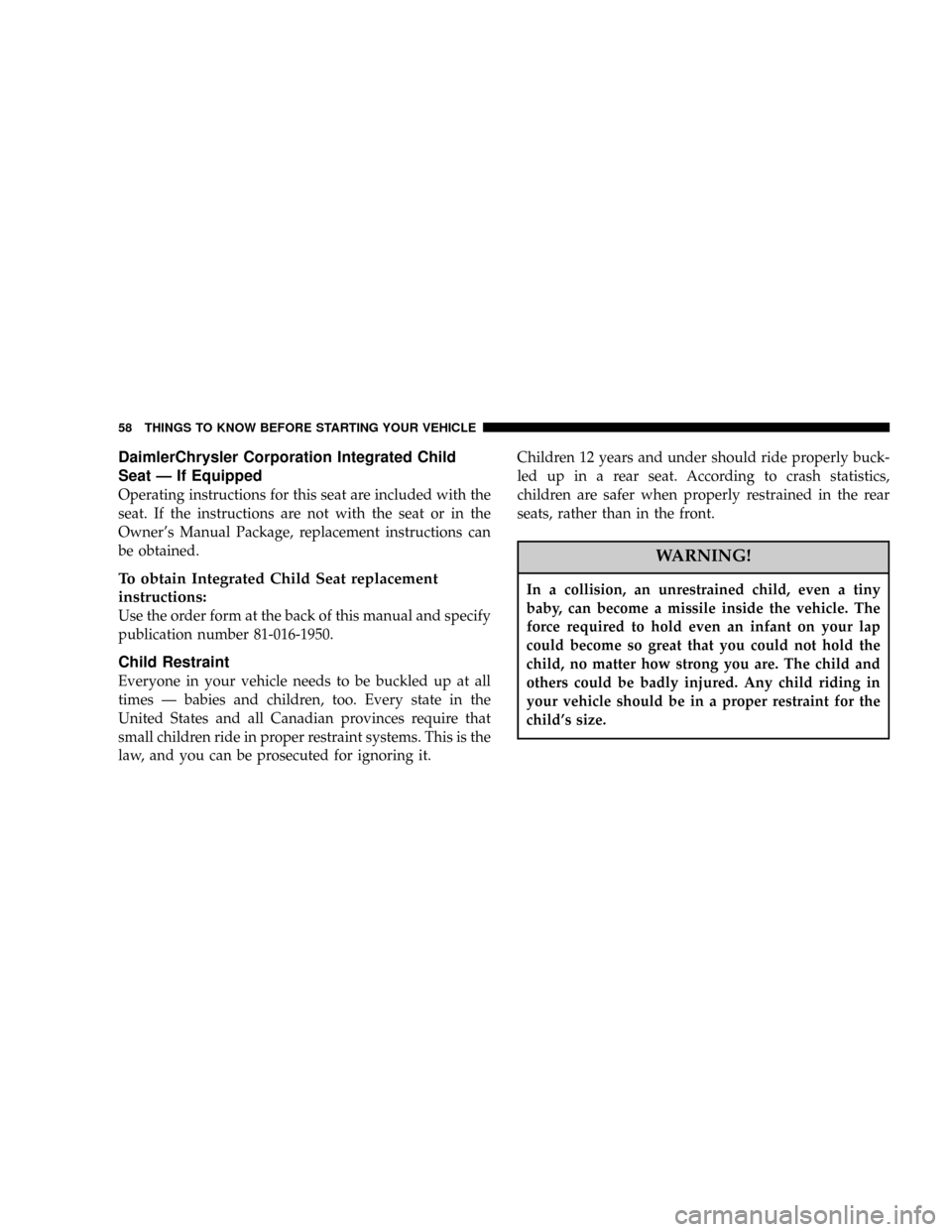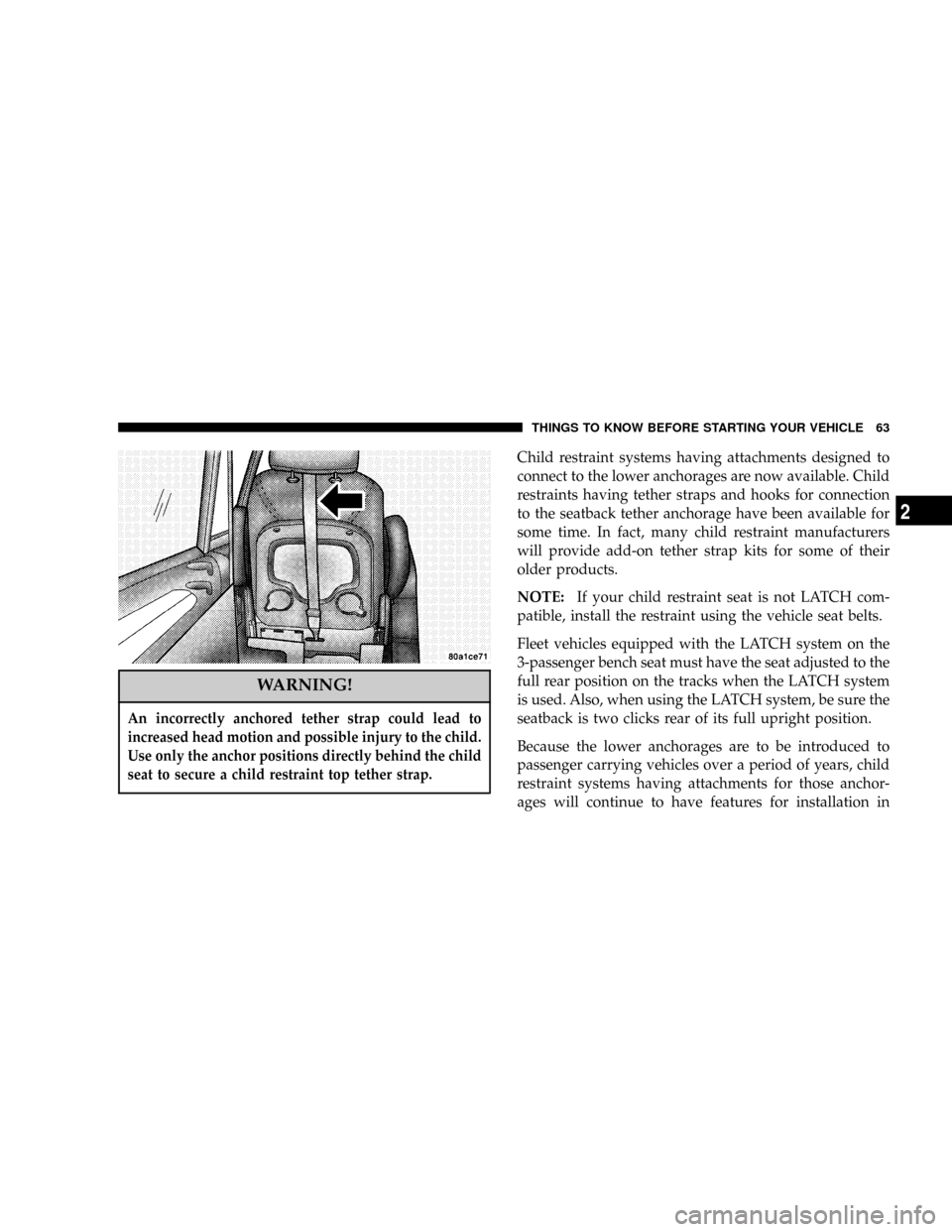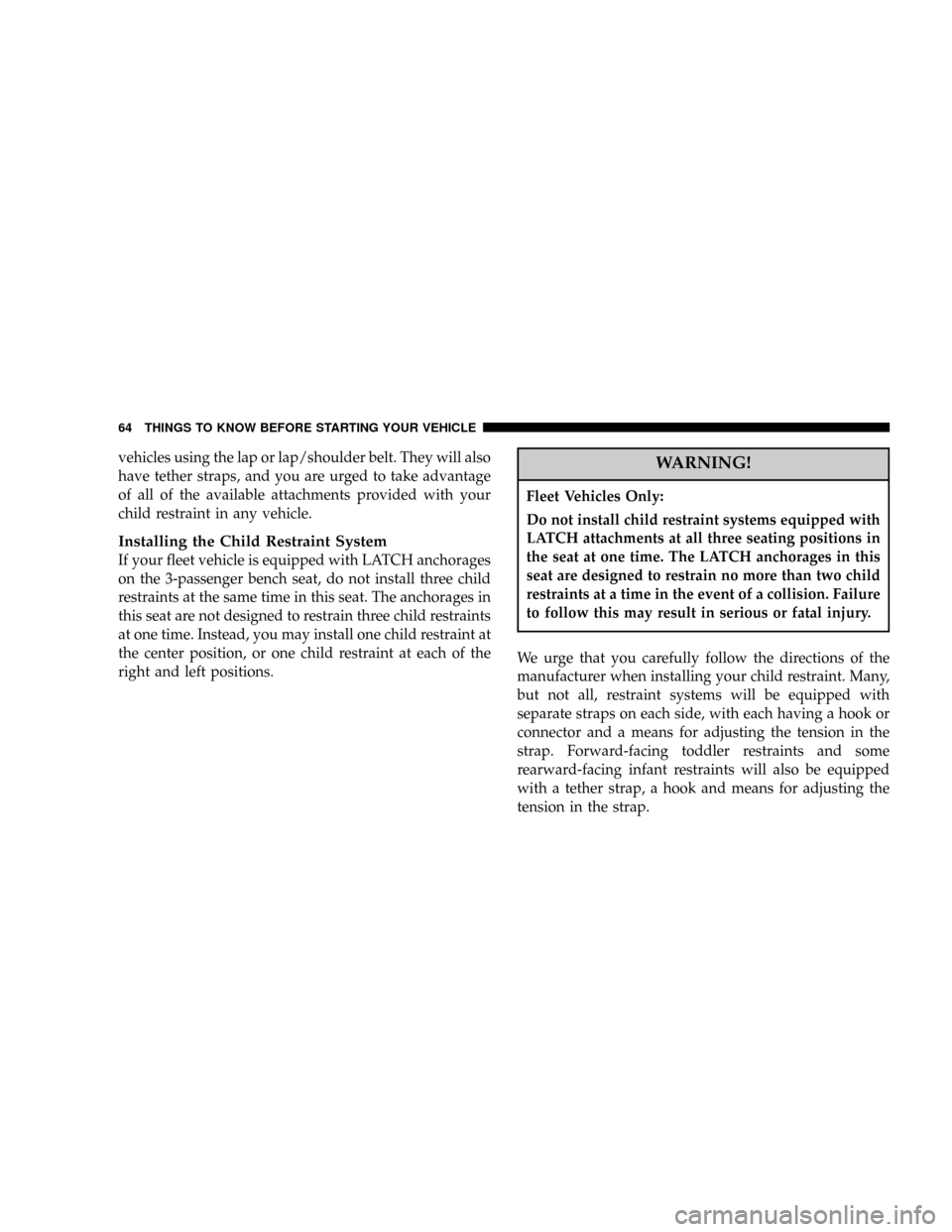child restraint DODGE CARAVAN 2004 4.G Owners Manual
[x] Cancel search | Manufacturer: DODGE, Model Year: 2004, Model line: CARAVAN, Model: DODGE CARAVAN 2004 4.GPages: 397, PDF Size: 6.83 MB
Page 10 of 397

mVehicle Theft Alarm Ð If Equipped...........26
mSliding Side Door........................28
NPower Sliding Door Ð If Equipped.........29
NChild Protection Door Lock...............32
mLiftgate...............................33
NPower Liftgate Ð If Equipped.............34
mWindows.............................36
NManual Rear Vent Windows...............36
NPower Vent Windows Ð If Equipped........36
NPower Windows Ð If Equipped............37
mOccupant Restraints......................38
NLap/Shoulder Belts.....................39NLap/Shoulder Belt Untwisting Procedure.....45
NCenter Lap Belts.......................47
NSeat Belt Pretensioners...................47
NSeat Belts And Pregnant Women............48
NSeat Belt Extender......................48
NDriver And Front Passenger Supplemental
Restraint System - Airbag................48
NSide Airbags Supplemental Restraint System
(SRS) Ð If Equipped....................54
NDaimlerChrysler Corporation Integrated Child
Seat Ð If Equipped.....................58
NChild Restraint........................58
10 THINGS TO KNOW BEFORE STARTING YOUR VEHICLE
Page 38 of 397

The power window switches remain active for up to 45
seconds after the ignition switch has been turned off.
Opening a vehicle front door will cancel this feature.
Wind Buffeting
Wind buffeting can be described as the perception of
pressure on the ears or a helicopter type sound in the
ears. Your vehicle may exhibit wind buffeting with the
windows down, or the sunroof (if equipped) in certain
open or partially open positions. This is a normal occur-
rence and can be minimized. If the buffeting occurs with
the rear windows open, open the front and rear windows
together to minimize the buffeting. If the buffeting occurs
with the sunroof open, adjust the sunroof opening to
minimize the buffeting.
OCCUPANT RESTRAINTS
Some of the most important safety features in your
vehicle are the restraint systems. These include the front
and rear seat belts for the driver and all passengers, front
airbags for both the driver and front passenger and if
equipped, side airbags for both the driver and front
passenger. If you will be carrying children too small for
adult-size seat belts, your seat belts or the LATCH feature
(Lower Anchors and Tether for CHildren) also, can be
used to hold infant and child restraint systems.
Please pay close attention to the information in this
section. It tells you how to use your restraint system
properly to keep you and your passengers as safe as
possible.
38 THINGS TO KNOW BEFORE STARTING YOUR VEHICLE
Page 51 of 397

1.Children 12 years old and under should always ride
buckled up in a rear seat.
Infants in rear facing child restraints shouldNEVERride
in the front seat of a vehicle with a passenger front airbag.
An airbag deployment can cause severe injury or death to
infants in that position.
Children that are not big enough to properly wear the
vehicle seat belt (refer to section on Child Restraint)
should be secured in the rear seat, in a child restraint or
belt-positioning booster seat. Older children who do not
use child restraints or belt-positioning booster seats
should ride properly buckled up in the rear seat, and in
the outboard seat if possible. Never allow children to
slide the shoulder belt behind them or under their arm.
If a child from 1 to 12 years old must ride in the front
passenger seat because the vehicle is crowded, move the
seat as far back as possible, and use the proper child
restraint. See the section on Child Restraint.You should read the instructions provided with your
child restraint to make sure that you are using it properly.
2.All occupants should wear their lap and shoulder
belts properly.
3.The driver and front passenger seats should be
moved back as far as practical to allow the front airbags
room to inflate.
4.If your vehicle has side airbags, do not lean against
the door, airbags will inflate forcefully into the space
between you and the door.
THINGS TO KNOW BEFORE STARTING YOUR VEHICLE 51
2
Page 58 of 397

DaimlerChrysler Corporation Integrated Child
Seat Ð If Equipped
Operating instructions for this seat are included with the
seat. If the instructions are not with the seat or in the
Owner's Manual Package, replacement instructions can
be obtained.
To obtain Integrated Child Seat replacement
instructions:
Use the order form at the back of this manual and specify
publication number 81-016-1950.
Child Restraint
Everyone in your vehicle needs to be buckled up at all
times Ð babies and children, too. Every state in the
United States and all Canadian provinces require that
small children ride in proper restraint systems. This is the
law, and you can be prosecuted for ignoring it.Children 12 years and under should ride properly buck-
led up in a rear seat. According to crash statistics,
children are safer when properly restrained in the rear
seats, rather than in the front.
WARNING!
In a collision, an unrestrained child, even a tiny
baby, can become a missile inside the vehicle. The
force required to hold even an infant on your lap
could become so great that you could not hold the
child, no matter how strong you are. The child and
others could be badly injured. Any child riding in
your vehicle should be in a proper restraint for the
child's size.
58 THINGS TO KNOW BEFORE STARTING YOUR VEHICLE
Page 59 of 397

Infants and Small Children
There are different sizes and types of restraints for
children from newborn size to the child almost large
enough for an adult safety belt. Always check the child
seat owner's manual to ensure you have the right seat for
your child. Use the restraint that is correct for your child:
²Safety experts recommend that children ride
rearward-facing in the vehicle until they are at least
one year old and weigh at least 20 lbs (9 kg). Two types
of child restraints can be used rearward-facing: infant
carriers and9convertible9child seats. Both types of
child restraints are held in the vehicle by the lap/
shoulder belt or the LATCH child restraint anchorage
system. Refer to ªLower Anchors and Tether for CHil-
dren (LATCH)º later in this section.
²The infant carrier is only used rearward-facing in the
vehicle. It is recommended for children who weigh up
to about 20 lbs (9 kg).9Convertible9child seats can beused either rearward-facing or forward-facing in the
vehicle. Convertible child seats often have a higher
weight limit in the rearward-facing direction than
infant carriers do, so they can be used rearward-facing
by children who weigh more than 20 lbs (9 kg) but are
less than one year old.
²Rearward-facing child seats mustNEVERbe used in
the front seat of a vehicle with a front passenger
airbag. An airbag deployment could cause severe
injury or death to infants in this position.
²Children who weigh more than 20 lbs (9 kg) and who
are older than one year can ride forward-facing in the
vehicle. Forward-facing child seats and convertible
child seats used in the forward-facing direction are for
children who weigh 20 to 40 lbs (9 to 18 kg) and who
are older than one year. These child seats are also held
in the vehicle by the lap/shoulder belt or the LATCH
THINGS TO KNOW BEFORE STARTING YOUR VEHICLE 59
2
Page 60 of 397

child restraint anchorage system. Refer to ªLower
Anchors and Tether for CHildren (LATCH)º later in
this section.
²The belt-positioning booster seat is for children weigh-
ing more than 40 lbs (18 kg), but who are still too small
to fit the vehicle's seat belts properly. If the child can
not sit with knees bent over the vehicles seat cushion
while the child's back is against the seat back, they
should use a belt-positioning booster seat. The child
and booster seat are held in the vehicle by the lap/
shoulder belt. (Some booster seats are equipped with a
front shield and are held in the vehicle by the lap
portion.)
NOTE:For additional information refer to
www.seatcheck.org.
WARNING!
²Improper installation can lead to failure of an
infant or child restraint. It could come loose in a
collision. The child could be badly injured or
killed. Follow the manufacturer's directions ex-
actly when installing an infant or child restraint.
²A rearward facing child restraint should only be
used in a rear seat. A rearward facing child re-
straint in the front seat may be struck by a
deploying passenger airbag which may cause se-
vere or fatal injury to the infant.
60 THINGS TO KNOW BEFORE STARTING YOUR VEHICLE
Page 61 of 397

Here are some tips on getting the most out of your child
restraint:
²Before buying any restraint system, make sure that it
has a label certifying that it meets all applicable Safety
Standards. We also recommend that you make sure
that you can install the child restraint in the vehicle
where you will use it, before you buy it.
²The restraint must be appropriate for your child's
weight and height. Check the label on the restraint for
weight and height limits.
²Carefully follow the instructions that come with the
restraint. If you install the restraint improperly, it may
not work when you need it.
The passenger seat belts are equipped with cinching
latch plates, which are designed to keep the lap
portion tight around the child restraint so that it is not
necessary to use a locking clip. Pulling up on theshoulder portion of the lap/shoulder belt will tighten
the belt. The cinching latch plate will keep the belt
tight, however, any seat belt system will loosen with
time, so check the belt occasionally and pull it tight if
necessary.
²In the rear seat, you may have trouble tightening the
lap/shoulder belt on the child restraint because the
buckle or latch plate is too close to the belt path
opening on the restraint. Disconnect the latch plate
from the buckle and twist the short buckle end of the
belt several times to shorten it. Insert the latch plate
into the buckle with the release button facing out.
²If the belt still can't be tightened, or if pulling and
pushing on the restraint loosens the belt, disconnect
the latch plate from the buckle, turn the buckle
around, and insert the latch plate into the buckle
again. If you still can't make the child restraint secure,
try a different seating position.
THINGS TO KNOW BEFORE STARTING YOUR VEHICLE 61
2
Page 62 of 397

²Buckle the child into the seat according to the child
restraint manufacturer's directions.
²When your child restraint is not in use, secure it in the
vehicle with the seat belt or remove it from the vehicle.
Don't leave it loose in the vehicle. In a sudden stop or
collision, it could strike the occupants or seatbacks and
cause serious personal injury.
Lower Anchors and Tether for CHildren (LATCH)
Each vehicle, except commercial cargo vehicles, is
equipped with the child restraint anchorage system
called LATCH, which stands for Lower Anchors and
Tether for CHildren. Two LATCH child restraint anchor-
age systems are installed on all second-row seats. Second-
row seats also feature tether strap anchorages, located in
the rear surface of the seatback. In addition, all
3-passenger bench seats are equipped with a child re-
straint tether anchor at the center seating position.When using the tether anchorages in the outboard seat-
ing positions, ensure that the strap is routed over the top
of the seatback and under the head restraint between the
head restraint posts. When the tether anchorage is used
in the center seating position, the strap should be posi-
tioned straight over the top of the seatback.
62 THINGS TO KNOW BEFORE STARTING YOUR VEHICLE
Page 63 of 397

WARNING!
An incorrectly anchored tether strap could lead to
increased head motion and possible injury to the child.
Use only the anchor positions directly behind the child
seat to secure a child restraint top tether strap.
Child restraint systems having attachments designed to
connect to the lower anchorages are now available. Child
restraints having tether straps and hooks for connection
to the seatback tether anchorage have been available for
some time. In fact, many child restraint manufacturers
will provide add-on tether strap kits for some of their
older products.
NOTE:If your child restraint seat is not LATCH com-
patible, install the restraint using the vehicle seat belts.
Fleet vehicles equipped with the LATCH system on the
3-passenger bench seat must have the seat adjusted to the
full rear position on the tracks when the LATCH system
is used. Also, when using the LATCH system, be sure the
seatback is two clicks rear of its full upright position.
Because the lower anchorages are to be introduced to
passenger carrying vehicles over a period of years, child
restraint systems having attachments for those anchor-
ages will continue to have features for installation in
THINGS TO KNOW BEFORE STARTING YOUR VEHICLE 63
2
Page 64 of 397

vehicles using the lap or lap/shoulder belt. They will also
have tether straps, and you are urged to take advantage
of all of the available attachments provided with your
child restraint in any vehicle.
Installing the Child Restraint System
If your fleet vehicle is equipped with LATCH anchorages
on the 3-passenger bench seat, do not install three child
restraints at the same time in this seat. The anchorages in
this seat are not designed to restrain three child restraints
at one time. Instead, you may install one child restraint at
the center position, or one child restraint at each of the
right and left positions.
WARNING!
Fleet Vehicles Only:
Do not install child restraint systems equipped with
LATCH attachments at all three seating positions in
the seat at one time. The LATCH anchorages in this
seat are designed to restrain no more than two child
restraints at a time in the event of a collision. Failure
to follow this may result in serious or fatal injury.
We urge that you carefully follow the directions of the
manufacturer when installing your child restraint. Many,
but not all, restraint systems will be equipped with
separate straps on each side, with each having a hook or
connector and a means for adjusting the tension in the
strap. Forward-facing toddler restraints and some
rearward-facing infant restraints will also be equipped
with a tether strap, a hook and means for adjusting the
tension in the strap.
64 THINGS TO KNOW BEFORE STARTING YOUR VEHICLE